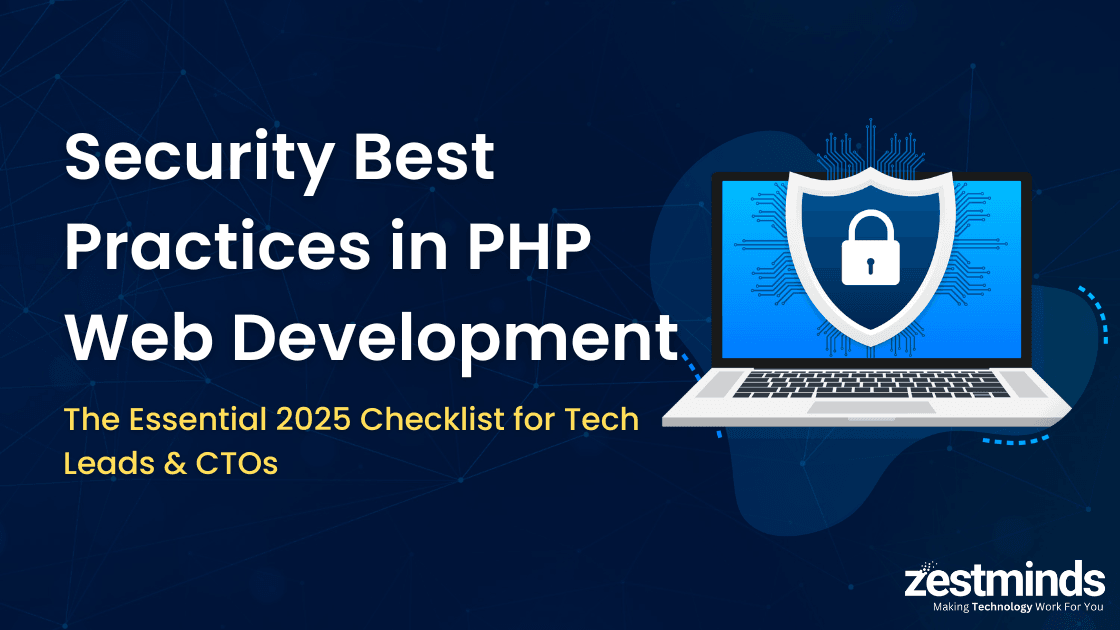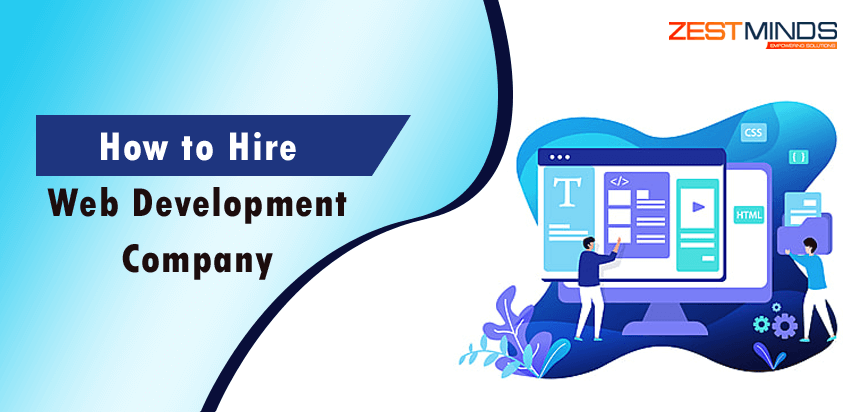How to Build Scalable Web Apps with Node.js and Microservices
Scalability isn’t a luxury anymore, it’s a must. In this guide, you’ll learn how technical founders and full-stack teams can build scalable web apps using Node.js and microservices. From battle-tested architecture patterns to real-world deployment tips, we’ve got you covered.
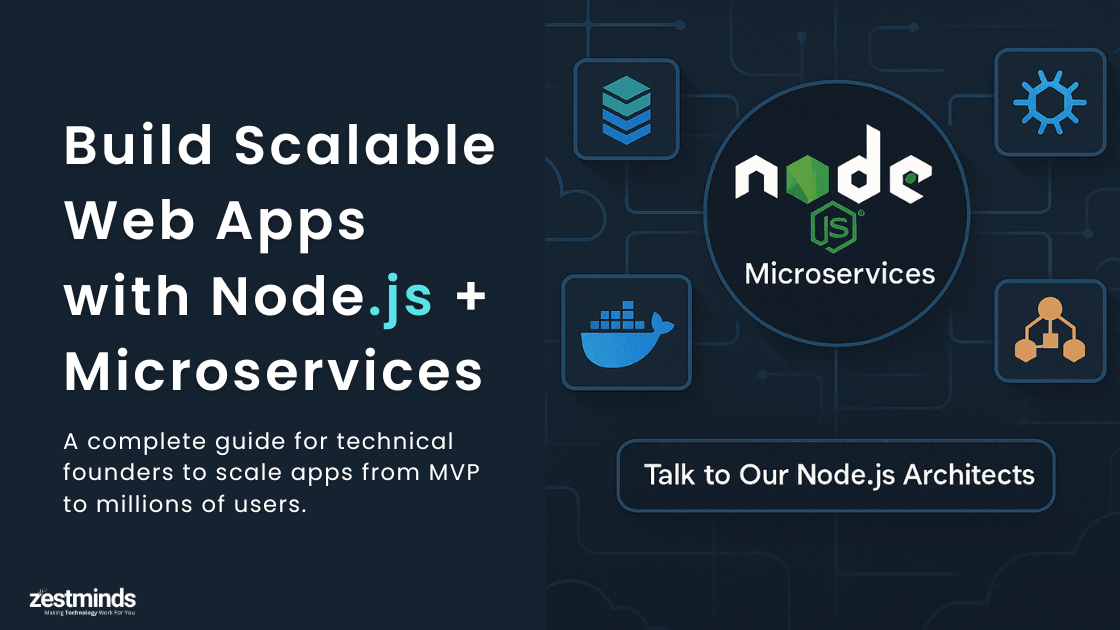
Why Node.js Is Built for Scale
Node.js is like the pit crew in Formula 1, fast, efficient, and never blocking the track.
Why founders love it:
- Non-blocking I/O: Handles thousands of concurrent users without threads
- Asynchronous by design: Keeps things lightweight and event-driven
- NPM ecosystem: Prebuilt tools for faster delivery
- Perfect for microservices: Small, modular services = easy scaling
"Netflix cut their startup time by 70% after switching to Node.js."
Need to go from MVP to hyperscale without starting over? Explore Zestminds' Node.js Development Services.
Microservices vs Monolith: Choose Smart, Not Fast
Before you dive in, pause. Architecture is destiny when it comes to scale.
Monoliths:
- Quick to launch
- One deploy = the whole app
- Turns into spaghetti at scale
Microservices:
- Modular, independent services (like Lego blocks)
- Scalable, testable, deployable in isolation
- Needs smart DevOps from day one
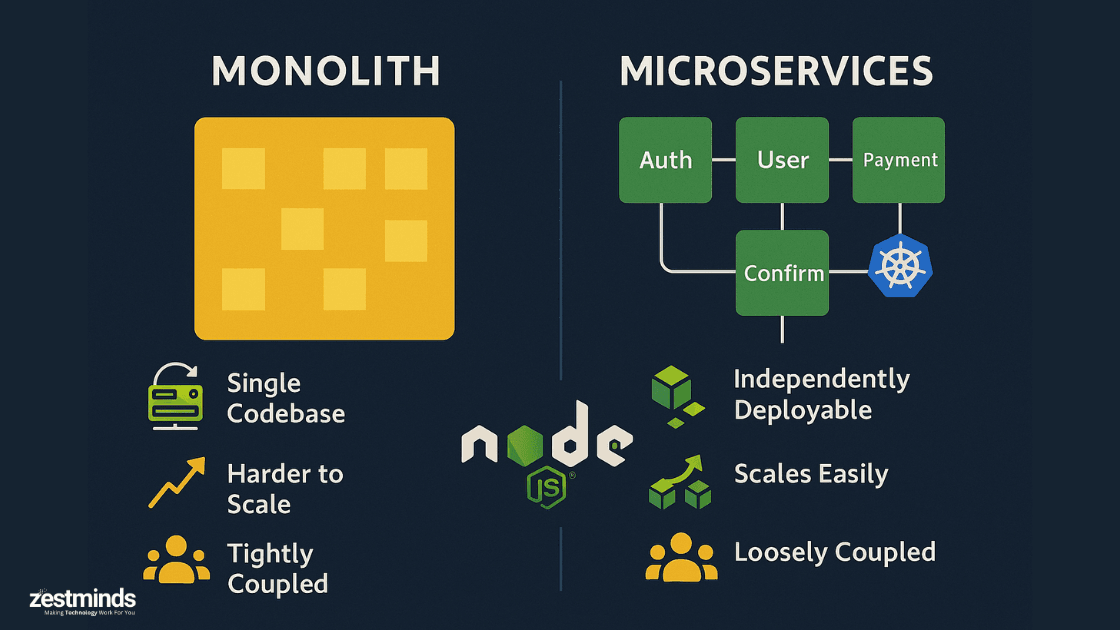
If you're under 1,000 users, start simple. But if you're building for tomorrow, architect with microservices in mind.
Here's how we design MVPs that scale.
Your Architecture Blueprint (with Node.js at the Core)
Want your app to handle 100 users today and 1 million next year? Use this base:
1. Define Your Microservices
Keep each service single-purpose, stateless, and API-driven.
Example Services:
- Auth & Users
- Payments
- Notifications
- Product Catalog
- Search & Recommendations
2. Tech Stack Cheatsheet
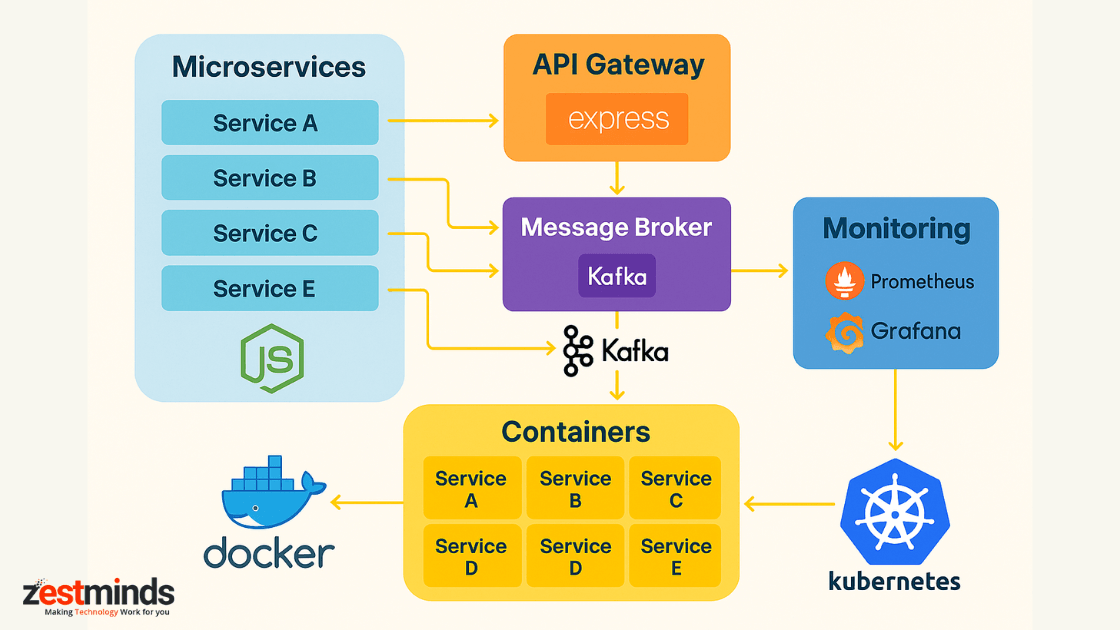
| Layer | Technology |
|---|---|
| API Gateway | Kong / Nginx / ExpressGW |
| Services | Node.js + Fastify/Express |
| Messaging | Kafka / RabbitMQ |
| Containers | Docker + Kubernetes |
| Monitoring | Prometheus + Grafana |
| CI/CD | GitHub Actions / Jenkins |
3. Use Asynchronous Messaging
Offload long tasks (emails, payments) using Kafka or RabbitMQ.
// Example Kafka publisher
producer.send({ topic: 'user-signup', messages: [{ value: 'New user registered' }] });
4. Leverage API Gateways
Gateways handle auth, routing, and traffic shaping so services stay lean.
Think of your API Gateway as the air traffic controller. It knows where every request should go.
5. Go All In on Containers
Dockerize every service. Use Kubernetes to deploy, scale, and heal them.
FROM node:18
WORKDIR /app
COPY . .
RUN npm install
CMD ["node", "server.js"]
6. Track Everything
You can't fix what you can't see. Use:
- Logs: ELK Stack
- Metrics: Prometheus + Grafana
- Errors: Sentry, Datadog
Companies using observability tools reduce downtime by 65%, many rely on the ELK Stack (Elasticsearch, Logstash, Kibana) to centralize logs and detect issues faster. ([Logz.io], [Red Hat])
For a detailed breakdown of ELK Stack and how it fits into observability pipelines, refer to Logz.io’s Complete Guide to the ELK Stack and Red Hat’s Introduction to ELK for Monitoring
Best Practices to Build for Hypergrowth
Scaling isn’t just about code. It’s about systems, culture, and anticipation. Here’s what top-performing Node.js teams do:
Stateless Everything
- Use Redis or JWT for sessions
- Avoid storing session/state data in memory
Horizontal > Vertical
- Use Node.js cluster module or Docker-based horizontal scaling
- Kubernetes makes scaling safer, faster, and observable
Async Always
app.get('/users', async (req, res) => {
const users = await db.findUsers();
res.send(users);
});
Prepare to Fail Gracefully
- Add retries and timeout logic in every API call
- Use circuit breakers for downstream dependencies
CDN + Caching = Happy Users
- Use Cloudflare or Akamai for static assets
- Set caching headers smartly at the API and edge layer
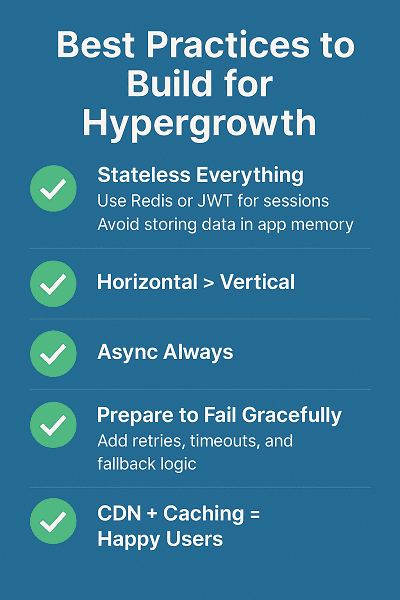
Real-World Scenario: Ride-Sharing at Scale
Let’s imagine you're building a ride-sharing app like Uber. Here’s how you’d structure it:
Key Microservices:
- Auth & Session Management
- Driver GPS Tracking
- Ride Matching
- Payments & Invoicing
- Notifications (SMS/Push/Email)
Scalable Patterns:
- Real-time GPS via WebSockets
- Ride dispatch using Kafka Pub/Sub
- Stripe for payments, Kafka for messaging workflows
Want to see a real example of this in action? Read our AI Ride Sharing App Case Study.
Common Pitfalls (And How to Avoid Them)
- Shared databases between services, causes coupling and deployment nightmares
- Synchronous API chains, latency explodes under load
- No monitoring or alerting, you’re flying blind
- Over-engineering too early, slows down learning and shipping
Start lean. Scale intentionally. Avoid tech debt traps and premature complexity.
Zestminds = Your Scaling Partner
We don’t just build code, we architect success. From MVP to enterprise-grade platforms, our Node.js expertise helps you scale fearlessly.
Our Node.js Development Services include:
- Fastify, NestJS, Express.js-based development
- CI/CD setup with GitHub Actions & Jenkins
- Docker + Kubernetes orchestration
- Kafka, RabbitMQ, and Pub/Sub-based architectures
- Logging, monitoring, observability baked-in
Ready to build what comes after MVP?
Book a free architecture call with our Node.js experts.
Frequently Asked Questions
What is the best way to scale a Node.js web app?
Use stateless services, asynchronous I/O, containerization with Docker, and orchestration via Kubernetes. Don’t forget observability.
Is Node.js suitable for large-scale enterprise apps?
Absolutely. Netflix, PayPal, Uber use Node.js in production serving millions. It’s scalable, fast, and modular.
How do microservices improve scalability?
They isolate features into independent services. Each can scale, deploy, and fail independently, removing single points of failure.
Also Read
More real-world architecture guides from Zestminds:

Shivam Sharma
About the Author
With over 13 years of experience in software development, I am the Founder, Director, and CTO of Zestminds, an IT agency specializing in custom software solutions, AI innovation, and digital transformation. I lead a team of skilled engineers, helping businesses streamline processes, optimize performance, and achieve growth through scalable web and mobile applications, AI integration, and automation.
Stay Ahead with Expert Insights & Trends
Explore industry trends, expert analysis, and actionable strategies to drive success in AI, software development, and digital transformation.

